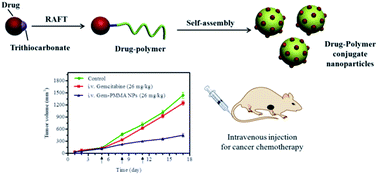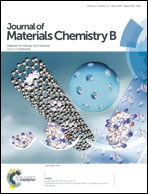Tailor-made gemcitabine prodrug nanoparticles from well-defined drug–polymer amphiphiles prepared by controlled living radical polymerization for cancer chemotherapy†
Abstract
The therapeutic efficacy of gemcitabine is severely compromised by its rapid plasma degradation and low tumor-targeting efficiency. Furthermore, the hydrophilic properties of gemcitabine also make efficient encapsulation and in vivo release of the compound difficult in a nanoscale drug delivery system. Herein, gemcitabine–poly(methyl methacrylate) (Gem–PMMA) conjugated amphiphiles were prepared from a gemcitabine-bearing trithiocarbonate initiator via reversible addition–fragmentation chain transfer (RAFT) polymerization. The prodrug conjugate with a high drug payload can self-assemble in water into nanoparticles with an average diameter of 130 nm. In addition, gemcitabine molecules within the Gem–PMMA nanoparticles mainly exist in an amorphous state, implicating better gemcitabine release. Indeed, the releasing kinetics of gemcitabine was pH-dependent and a controlled release of gemcitabine from the nanoparticles was observed with 71.6% of cumulative drug release in 72 h in the presence of protease cathepsin B. The cytotoxicity of the gemcitabine prodrug nanoparticles was evident as demonstrated by an in vitro viability assay using human pulmonary carcinoma, A549, and breast cancer cells, MCF-7. In vivo assessment of the gemcitabine-loaded nanoparticles using BALB/c nude mice with A549 cell derived xenograft tumors indicated that these intravenously administered nanoparticles efficiently inhibit tumor growth as well as alleviate the drug-associated side effects at a dose of 26 mg kg−1. In summary a prodrug nanoparticle, Gem–PMMA, with excellent delivery efficiency and tumor growth inhibition efficacy, was designed and produced. Our results demonstrated the potential of the gemcitabine prodrug nanoparticles as a promising therapeutic formulation for chemotherapy.


 Please wait while we load your content...
Please wait while we load your content...